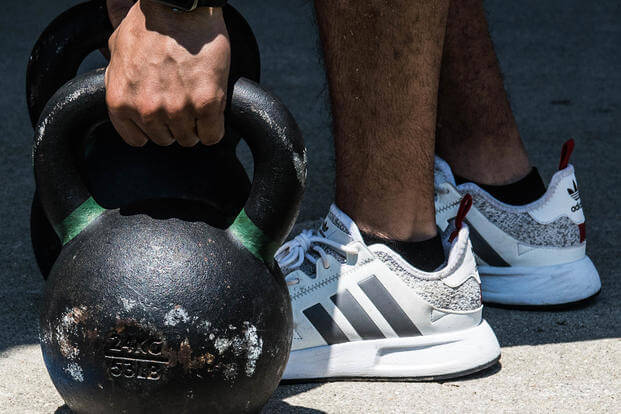If you want to combine lifting, running, swimming and calisthenics into one training regimen, that program will require special attention to balance and recovery. If you do too much of each activity in combination, you're likely to see little or no improvement in strength, muscle stamina or endurance.
That result is fine if the goal is to maintain your current level of fitness, but if you want to improve elements of fitness that do not improve together, you may want to do a few specific training cycles that address your weaknesses.
Here is a very common question from a young man preparing for military service who wants to be competitive in future selection programs.
Stew, I am currently getting my PT scores to competitive levels by focusing solely on running, swimming and calisthenics. However, I would like to add lift training to address areas that calisthenics do not thoroughly help. Any advice on adding weight training with high-repetition calisthenics and higher-volume cardio training? Thanks, Paul
Paul, that's a great question. I have seen many people ruin cycles of progress by adding in too much of other types of training in a cycle when they're trying to focus on a different type of training and energy system.
However, new fitness tests in the military such as the Army combat fitness test (ACFT) will require you to add strength training. Here is how I would recommend adding supplemental lifts into training weeks or creating short cycles to develop all the elements of fitness without overuse and creating negative results.
1. Maintain with Supplemental Lifts
If you are looking to maintain all the elements of fitness and not necessarily improve in any particular one, then you can do all the elements of fitness in a single workout but with logical split routines for recovery.
For instance, warm up with higher-repetition calisthenics by doing a warmup pyramid that is focused on the muscle group being worked that day (upper body or lower body). Add in some cardio activity (run, swim, ruck) mixed with more calisthenics to build the volume of muscle stamina you need.
Finish the workout with a cooldown cardio event to top off any endurance needs. Later in the day, if you have the energy, add in a supplemental lift workout for 3-4 sets of 8-10 reps of the lifts associated with the same muscle groups you worked earlier that day.
Upper-body calisthenics are followed by upper-body lifts. Lower-body calisthenics are followed by lower-body lifts later in the day. Do not try for heavy one-rep max lifts. This cycle is for maintenance.
2. Improve Strength, Maintain Endurance
In this cycle, you can still warm up with calisthenics, but make the meat of your workout focused on the lift. Be strength- or power-oriented with heavier lifts and movements.
Then follow with some cardio for endurance maintenance. You do not want to run, swim or ruck too much, so focus more on speed and pace for 20-30 minutes after heavier lift events. This way, you can see gains in strength while maintaining some level of endurance.
Another option is to create a block periodization model that incorporates three weeks of strength training with minimum endurance training (just the basics). Every fourth week, focus on calisthenics and cardio training as a strength training deload week.
I have been recommending this lifting cycle for years to those who need to improve strength while maintaining a high-level fitness test score (endurance plus muscle stamina = calisthenics and cardio).
3. Improve Endurance and Muscle Stamina, Maintain Strength
Do a cycle of calisthenics and cardio-based training with minimum lifting, other than auxiliary lifts with kettlebells added to swings, squats and farmer walks or dumbbells for overhead press, rows and curls.
You still warm up with calisthenics and continue higher repetitions of calisthenics mixed with cardio activities (run, bike, swim, ruck, etc.), followed by challenging goal-pace running, sprints, hills and longer-distance cardio events.
You do this, too, on a three-week cycle, followed by one week of strength training with a running volume and calisthenics repetition deload. This is a good way to add strength while recovering from high reps and miles of running for one week in every four-week cycle. You definitely will see fewer overuse injuries, such as tendinitis, shin splints or joint pains.
The right answer truly depends on your goals, athletic history, training strengths and weaknesses. There are smarter ways to get good at everything, but for the most part, you must cycle specific training types so you don't see the plateaus or negative results that heavy lifting and longer-distance running can create when done together.
When you do both at high levels together in the same day or week, you will not see improvements in either strength or endurance. But in several weeks or a few months, you can see improvements in both when you properly arrange your training weeks. Do research on training periodization or block periodization.
Stew Smith is a former Navy SEAL and fitness author certified as a Strength and Conditioning Specialist (CSCS) with the National Strength and Conditioning Association. Visit his Fitness eBook store if you're looking to start a workout program to create a healthy lifestyle. Send your fitness questions to stew@stewsmith.com.
Want to Learn More About Military Life?
Whether you're thinking of joining the military, looking for fitness and basic training tips, or keeping up with military life and benefits, Military.com has you covered. Subscribe to Military.com to have military news, updates and resources delivered directly to your inbox.




















